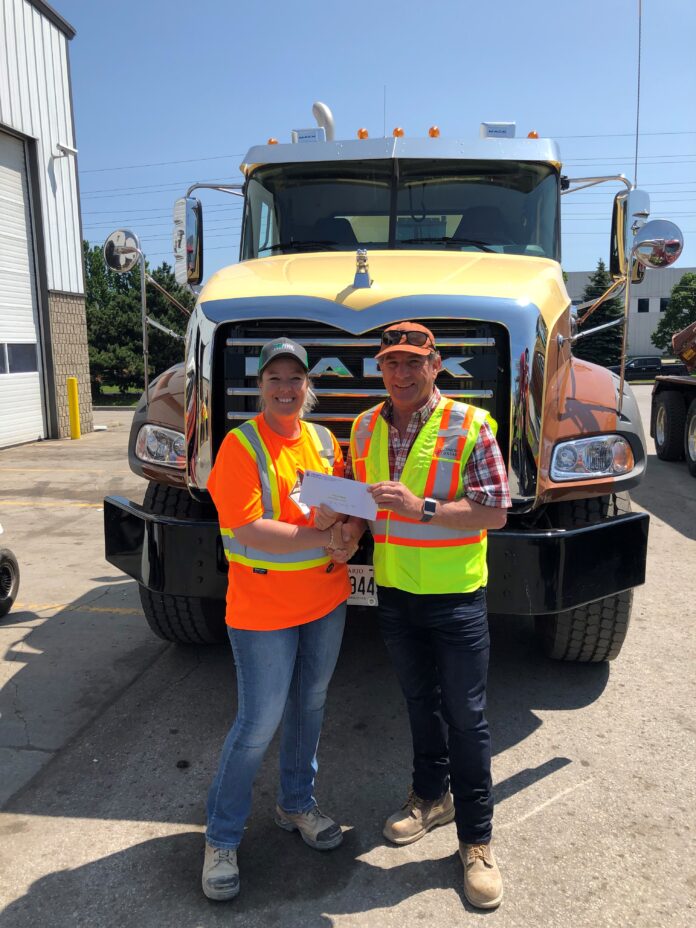By Donna Mayer
Special to Ontario Construction Report
As demand for skilled labour continues to increase, attracting women to the trades has never been more important. For hauling and trucking companies, the timing couldn’t be better.
“The whole industry changed in order to make it easier for women to come into the industry,” says Gina Zinger, a 20-year veteran who worked her way up the ladder from student, driver, trainer and now operations manager for a group of 150 drivers.
Citing everything from ratcheting bars, truck design and moving peddles, to facilities for women, Zinger says “the industry has changed quite a bit in 20 years.”
Zinger was working in road construction with an asphalt crew when she decided to pursue a career in trucking 20 years ago.
“I was the instigator of that,” she says, “Guess what? Women can do the job.”
Zinger attended the Ontario College of Trades for their tractor-trailer course. She also went to the Northern Academy of Transportation Training (NATT) near Sudbury for their six-week AZ course, with one week of in-class theory and then five weeks in truck.
“They were minimum 12-hour shifts, day shift and night shift, and we worked with two different types of transmissions at that time, one was 13 and 15 speed manual transmissions.”
Starting as long haul, moving into day shift runs, running team, spare board, and controlled run/short run, Zinger spent 12 years as a transport driver.
”My experience for the most part was good. I expected that the older drivers, you know 50 plus, I thought they would be the ones that would give me a hard time. And it wasn’t at all,” she says. “It was the drivers that were my age that had a wife and children at home that were not happy if I got a shift and they didn’t.”
There were very few female drivers at that time, except for a few running team with their partners.
The shortage of truck drivers in Ontario continues to be a major challenge for the concrete industry, where finding and keeping qualified drivers has never been more crucial.
Recognizing women only represent about three per cent of the trucking workforce in Canada has prompted government and corporate funding, additional educational and training resources and the emergence of new associations that encourage employment of women in trucking, promote their accomplishments, and minimize obstacles to working in the industry.
As a result, there has been a shift in the traditionally male-dominated industry as various groups strengthen the trucking industry’s diversity practices and increase gender parity.
Concrete Ontario represents over 90 companies across the province and hosts events including an annual truck rodeo to showcase and celebrate members’ skills. In 2019, for the first time, the rodeo winner was a woman, Colleen Lizotte.
“Our experience has revealed that much of the recruitment challenges for women into the concrete industry is related to perception,” says Concrete Ontario president, Bart Kanters.
“We’ve started investing in capturing and sharing the stories and successes of women already working as Concrete Delivery Professionals, starting with the story of our first woman Concrete Mixer Rodeo winner.”
“Sharing these stories is a double-win,” says Kanters. “It helps our members understand the needs of women Concrete Delivery Professionals, and also highlights to other women how rewarding these careers can be.”
Upon her rodeo win Lizotte said she found her “happy place” behind the wheel of a Miller-EC King Concrete truck.
That’s a reality that Zinger, who shifted from driver to trainer for family reasons after 12 years, understands.
“We were pushing our 70-hour clock quite a bit,” she says. “I didn’t want to give it up. I loved it.”
Zinger discovered that being a driver trainer was great as well. “You got to share your knowledge one on one.” As a female driver trainer, she also got to be a role model.
“One woman came up to me and said you’re the reason I am here,” she says.
According to the Truck Training Schools Association of Ontario (TTSAO), Commercial Drivers Licence (CDL) training can be completed in as little as eight weeks and graduates can be employed almost immediately.
Provincial mandatory entry-level training (MELT) includes at least 103.5 hours of instruction and covers the entry-level knowledge and skills needed to safely operate a large truck on Ontario’s roads. It must be completed and recorded on the driver’s record prior to the road test.
What is Zinger’s advice to women truck drivers? “Ask questions. Listen to the answers. And apply as necessary. The worse thing somebody can do is ask a question and not listen to an answer.”
“That is what helped me to survive. If I didn’t know something I would ask another driver. Most of them love to share their knowledge, help somebody else out. And it doesn’t matter if you are male or female.”

